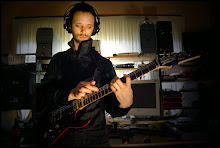Elder Conservatorium Music Tech Weekly 08/06/06

Audio Arts:
Studio Mixing:

Audio Arts in the audio lab? Who would have thought? This situation was highly beneficial however, as I was able to immediately apply some of the techniques discussed to my major project.
Topics covered include:
- Frequency isolation
- Delay
- Volume
- Panning
- Noise gates
- Reverb
- And compression
Being given a useful chart outlining the various frequency bandwidths of conventional instruments allowed me to start applying constructive EQ to the mix.
This significantly reduced the ‘muddiness’ that was evident in the raw session data.
I have also applied a gate to the kick and snare drums - be careful if the player uses a light touch from time to time though. I didn’t quite follow the concept of offset / onset delay, but I will perform my own experiments in this area regardless.
Creative Computing:
Tape Techniques continued – L’object sonore:
I think I understand the Music Concrete theory a little more. If one aspires to dereference a sound from its original function or form, and apply this to all or many of the sounds they are working with, in a sample based project – the project will be well on the way to turning up new ideas, and perhaps even entirely new sounds. It’s the concept of working on something specific in a non conventional way to avoid the clichés and traps of traditional approaches.
I have been waiting for someone to explain how to use a gate plug in for breaking up an incoming signal for musical purposes. After today my wait is over:
- Audio 1 (containing rhythmic sound) – send to bus 1
- Audio 2 (containing signal to be manipulated) – insert gate plugin
- Gate plug in – change key input to bus 1
- Simple
Listening Workshop:
1. Steve Reich: Electric Counterpoint, movement one – fast:
Staccato notes fading in and out. Not much of a concept, until you add some tasteful harmony, clever use of echo / delay and panning, and Pat Metheney on guitar. Despite the simple arrangement, this piece sounds very wide and complete. I suspect Pat is using a split pickup to separate panning control of each individual string. The rhythmic pattern did get a bit tired toward the end, but it was overall a good listen.
2. Tristram Carey: Soft Walls – 1980:
Soft walls is a great title. The electronic sounds on display are distinctly soft and non grating even when there is dissonance in the harmony. It was performed on a Synclavier, so we are talking about some early digital electronic music here. The Synclavier was invented in the late 70's so the quality of recording is notably higher than examples of electronic music from the sixties.
3. Pink Floyd: Interstellar Overdrive – 1966:
This one starts out as an odd 60’s rock song, but quickly develops into a weird interlude reminiscent of Led Zep’s whole lotta love. There’s some evidence of developing guitar techniques such as pick scraping, tapping, dive bombs and muted power chord riffing. This tangent stretches out for a long period before it recapitulates to a classic rock ending.
4. Steve Reich: Different Trains, final movement, after the war – 1988
A collage of various train station PA calls accompanied by a string quartet hey?
This wasn’t really doing it for me until the harmonised steam engine horns kicked in. They complemented the string work beautifully. The changes were a bit abrupt, although this was probably to do with the subject matter being spoken at the time.
5. Tristram Carey: Steam Music:
This tape collage gave the impression of trains communicating with each other. It gets very intense at the halfway point, suggesting the trains are on the run from something and panicking. Very effective.
References:
Christian Haines. "Audio Arts – Mixdown Basics." Practical Class presented at the Audio Lab, 4th floor, Schulz Building, University of Adelaide, 06 June, 2006.
Christian Haines. "Creative Computing – Tape Techniques pt 2." Lecture presented at the Audio Lab, 4th floor, Schulz Building, University of Adelaide, 08 June, 2006.
David Harris. "Music Technology Listening Workshop – Steve Reich, Tristram Carey and Pink Floyd." Lecture presented at the Electronic Music Unit, EMU space, University of Adelaide, 08 June, 2006.


2 Comments:
I agree with the Steve Reich (Different Trains) comment.... I was waiting for something to "happen" in the piece, and of course it did. I really enjoyed the combination of train whistle with the strings. Nice chords too.
Well where are you Bach? Go on flame me, I dare you
Post a Comment
<< Home